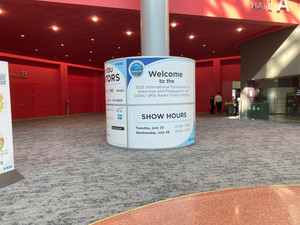I'm pleased to report on my participation in IEEE AP-S 2023, which stands as the most significant and highly esteemed international conference in antennas and propagation research.
Presentation Overview
The research, "A Novel Loop Antenna Easily Matching with Radio Frequency Integrated Circuit Chips," was presented at the 2023 IEEE International Symposium on Antennas and Propagation and the USNC-URSI Radio Science Meeting in Portland, Oregon, USA.
T. Kanamori and M. Matsunaga, "A Novel Loop Antenna Easily Matching with Radio Frequency Integrated Circuit Chips," 2023 IEEE International Symposium on Antennas and Propagation and USNC-URSI Radio Science Meeting (USNC-URSI), Portland, OR, USA, 2023, pp. 1499-1500, doi: 10.1109/USNC-URSI52151.2023.10237905.
For reprints, please reach out to me via ResearchGate.
This paper represents a milestone in the ongoing collaborative effort within Shizuoka University to develop high-efficiency rectennas. A rectenna—a term coined from "Rectifying Antenna"—is a single unit that incorporates both a rectifying circuit and an antenna.
Tanizawa Lab, specializing in LSI design, is leading the rectifier circuit aspect, while Matsunaga Lab focuses on the antenna component. Our study centers on optimizing the rectifier circuit's efficiency by carefully considering its input impedance and aligning it with the antenna's impedance.
RFID tag chips inherently possess a complex impedance due to their structural constraints, necessitating a matching antenna impedance. Previously, efforts were concentrated solely on this impedance matching. However, considerations for optimizing the rectifying efficiency, accounting for the entire rectenna circuit, have been lacking. This gap partly exists because of limitations in the achievable complex impedance values for antennas.
The antenna discussed in this presentation distinguishes itself by easily matching with LSI chips, while maintaining radiation characteristics akin to conventional dipole antennas.
Although initially concerned about the limited attendance, I was pleasantly surprised when the audience swelled considerably just prior to my talk, allowing for a fruitful exchange of ideas through numerous questions.
However, I was astonished to encounter a lingering belief that "an antenna's input impedance should be 50Ω," despite two decades of RFID applications. Moreover, there appears to be a noticeable gap in expertise regarding the measurement methodologies for antennas with non-standard input impedances.
This experience has reinforced my commitment to produce research that not only resonates with, but is also practically beneficial to, a broad audience.
Photo Captions: Left - A signboard at the venue entrance. Right - A panoramic shot of the venue taken from a neighboring high-rise, capturing the lively atmosphere of the opening plaza where attendees mingled.
|
|
|

